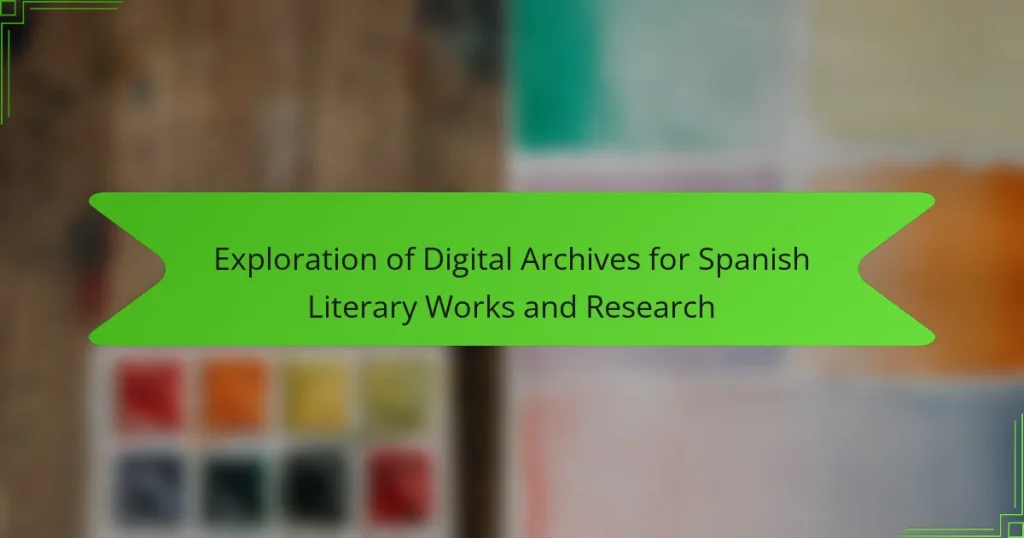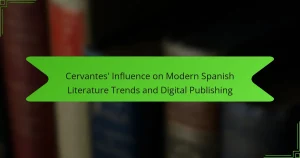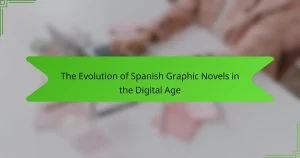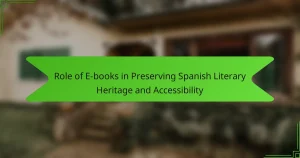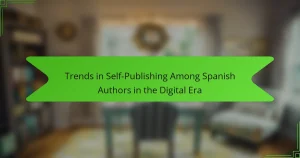Digital archives significantly enhance access to Spanish literary works, offering preservation and research opportunities. They provide unique resources like original manuscripts and rare editions. Researchers can utilize advanced search tools and metadata to analyze texts efficiently. Challenges include accessibility issues and the need for user-friendly interfaces, while community contributions enrich the archives with diverse perspectives. Emerging technologies are shaping these platforms, improving accessibility and engagement with Spanish literature.

How do digital archives enhance access to Spanish literary works?
Digital archives significantly enhance access to Spanish literary works by providing widespread availability, preserving historical texts, and facilitating research. These platforms allow users to explore vast collections, increasing engagement with Spanish literature.
Digital archives preserve unique attributes of literary works, such as original manuscripts and rare editions, ensuring their longevity. For example, the digitization of works from the Golden Age of Spanish literature opens access to texts that were previously limited to physical libraries.
As a result, researchers can analyze and compare texts more efficiently, utilizing search functions to locate specific passages or themes. This ease of access encourages interdisciplinary studies, connecting literature with history, culture, and language studies.
Moreover, digital archives often include metadata that describes the context and significance of each work, enriching the research experience. This comprehensive approach ultimately fosters a deeper understanding of Spanish literary heritage and its impact on contemporary culture.
What are the key benefits of using digital archives for researchers?
Digital archives provide researchers with enhanced accessibility, preservation of rare texts, and opportunities for collaboration. They allow for efficient searches and retrieval of information, making it easier to analyze Spanish literary works. Digital formats preserve original texts while offering tools for annotation and cross-referencing, enriching the research process. As a result, researchers can engage with a broader range of materials, fostering deeper insights into literary studies.
Which platforms are most popular for accessing Spanish literary archives?
The most popular platforms for accessing Spanish literary archives include Google Books, Project Gutenberg, Biblioteca Virtual Miguel de Cervantes, and HathiTrust. These platforms offer extensive collections of Spanish literary works, enhancing research opportunities. Google Books provides digitized texts, while Project Gutenberg focuses on public domain works. Biblioteca Virtual Miguel de Cervantes specializes in Spanish literature and cultural heritage. HathiTrust offers a vast repository of digitized books and journals, making it a valuable resource for researchers.
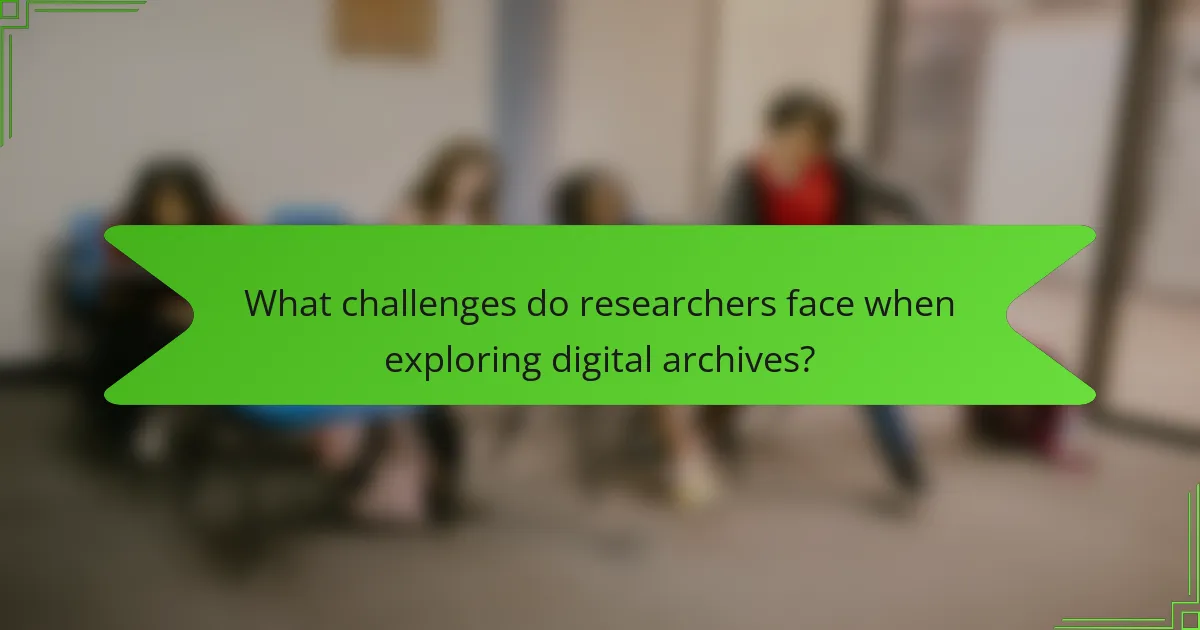
What challenges do researchers face when exploring digital archives?
Researchers face several challenges when exploring digital archives of Spanish literary works. These include issues with accessibility, data organization, and preservation of materials.
Access to digital archives can be limited due to copyright restrictions or inadequate digital infrastructure. Many archives lack user-friendly interfaces, complicating the search process. Additionally, the organization of materials may be inconsistent, making it difficult to locate specific works or authors.
Preservation of digital content is another concern, as formats may become obsolete or files may deteriorate over time. Researchers must navigate these challenges to effectively utilize digital archives for their literary studies.
How does copyright impact access to Spanish literary works in archives?
Copyright significantly restricts access to Spanish literary works in archives, limiting availability for research and public use. Copyright laws protect authors’ rights, often preventing the digitization and distribution of works without permission. This restriction can hinder scholars’ ability to analyze and engage with the literature. Digital archives may face legal challenges when attempting to provide access to copyrighted materials, impacting the breadth of research available. As a result, many valuable texts remain inaccessible, which can stifle academic discourse and cultural appreciation.
What technical issues are common when using digital archives?
Common technical issues when using digital archives include accessibility problems, data format incompatibility, and inadequate metadata. Users may struggle to access certain materials due to platform limitations or software requirements. Additionally, outdated or unsupported file formats can hinder the retrieval of resources. Metadata inconsistencies can lead to challenges in locating relevant Spanish literary works, affecting research efficiency.
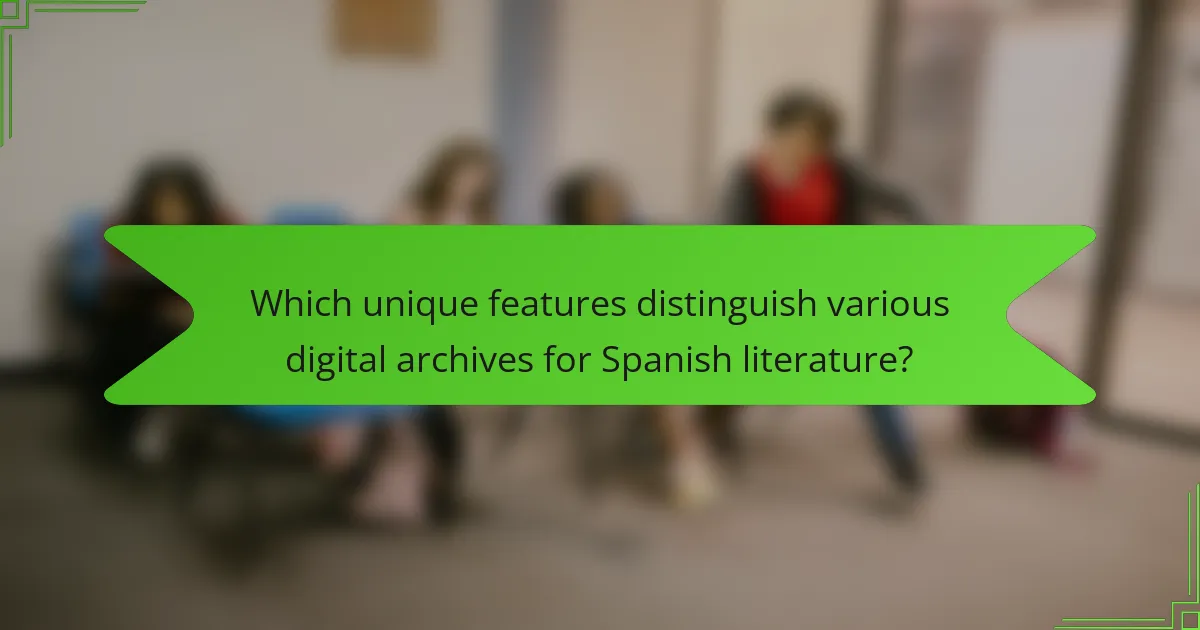
Which unique features distinguish various digital archives for Spanish literature?
Digital archives for Spanish literature differ through unique features like accessibility, user interface, and content variety.
One notable archive is the HathiTrust Digital Library, which offers extensive searchable collections and collaborative tools. The Biblioteca Digital Hispánica provides rich visual resources, emphasizing rare manuscripts.
Another example is the Proyecto Gutenberg, known for its vast selection of public domain texts and user-friendly format options. The Repositorio Institucional de la Universidad de Salamanca focuses on academic research, providing specialized scholarly resources.
These distinct attributes enhance research opportunities and engagement with Spanish literary works.
How do user interfaces vary across different digital archives?
User interfaces in digital archives for Spanish literary works can vary significantly based on design choices and user needs. Key differences include layout, navigation, and accessibility features.
For instance, some archives prioritize visual aesthetics with engaging graphics, while others focus on straightforward navigation to enhance usability. Additionally, certain platforms may offer advanced search options, allowing users to filter by author or genre, whereas others might provide a more basic search functionality.
Accessibility features also differ; some archives incorporate tools for users with disabilities, such as screen readers or adjustable text sizes. These variations impact user experience and engagement with the archive’s literary resources.
Ultimately, the effectiveness of a digital archive’s user interface is determined by how well it meets the specific needs of researchers and readers exploring Spanish literature.
Which archival collections are considered rare or exclusive?
Rare or exclusive archival collections related to Spanish literary works often include unique manuscripts, first editions, and unpublished materials. Notable examples are the Biblioteca Nacional de España’s collection of Cervantes’ works and the Fundación Juan March’s archives of 20th-century Spanish literature. These collections provide invaluable resources for research and exploration.
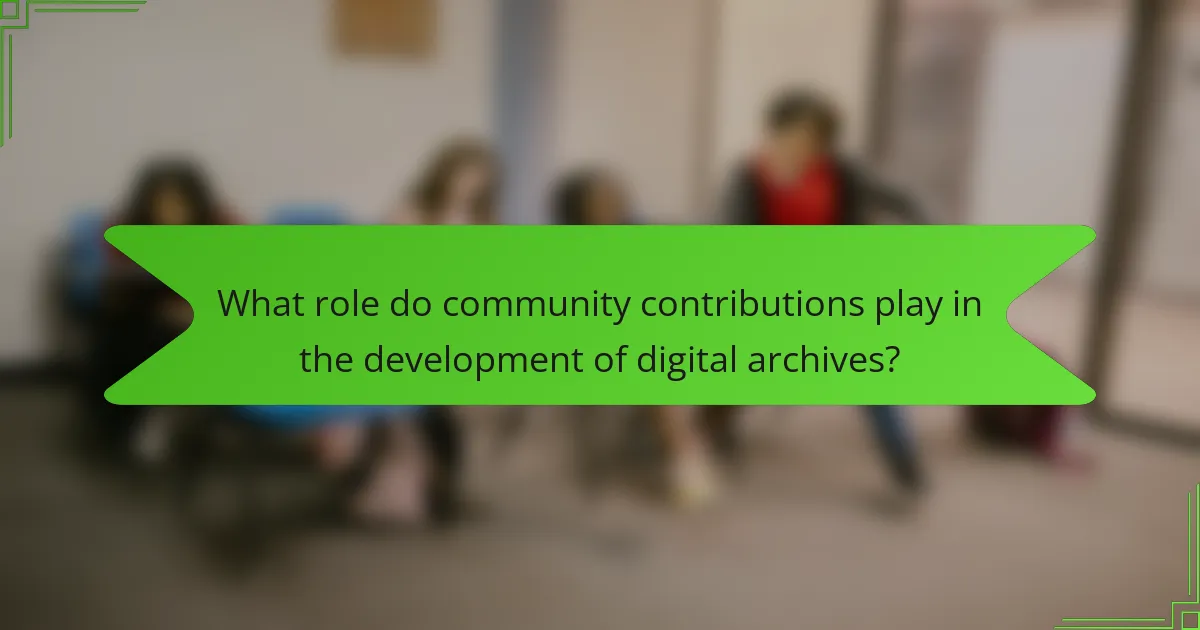
What role do community contributions play in the development of digital archives?
Community contributions significantly enhance the development of digital archives by enriching content and fostering collaboration. These contributions allow diverse perspectives on Spanish literary works, creating a more comprehensive resource. Engaging local scholars and enthusiasts results in unique insights and rare materials that may not be captured through traditional archiving methods. Additionally, community involvement promotes ongoing maintenance and updates, ensuring the archives remain relevant and accessible.
How can users contribute to the enrichment of digital literary collections?
Users can enrich digital literary collections by contributing original works, annotations, and research insights. Engaging with platforms hosting Spanish literary archives fosters collaboration and knowledge sharing.
User-generated content, such as essays or critiques, enhances the richness of these collections. Additionally, sharing translations or adaptations can broaden accessibility and appreciation of Spanish literature.
Participating in forums or discussions related to these archives encourages community involvement. Users can also volunteer for digitization projects, ensuring more works are preserved and available for future research.
By utilizing social media to promote these collections, users can attract new audiences and contributors, ultimately enriching the digital literary landscape.
What are the best practices for collaborating on archival projects?
Effective collaboration on archival projects requires clear communication, defined roles, and shared goals among team members. Establishing a digital platform for document sharing enhances accessibility and encourages real-time feedback. Regular meetings promote alignment and address challenges promptly. Utilizing project management tools can streamline tasks and track progress efficiently. Engaging with stakeholders ensures diverse perspectives and enriches the archival content.
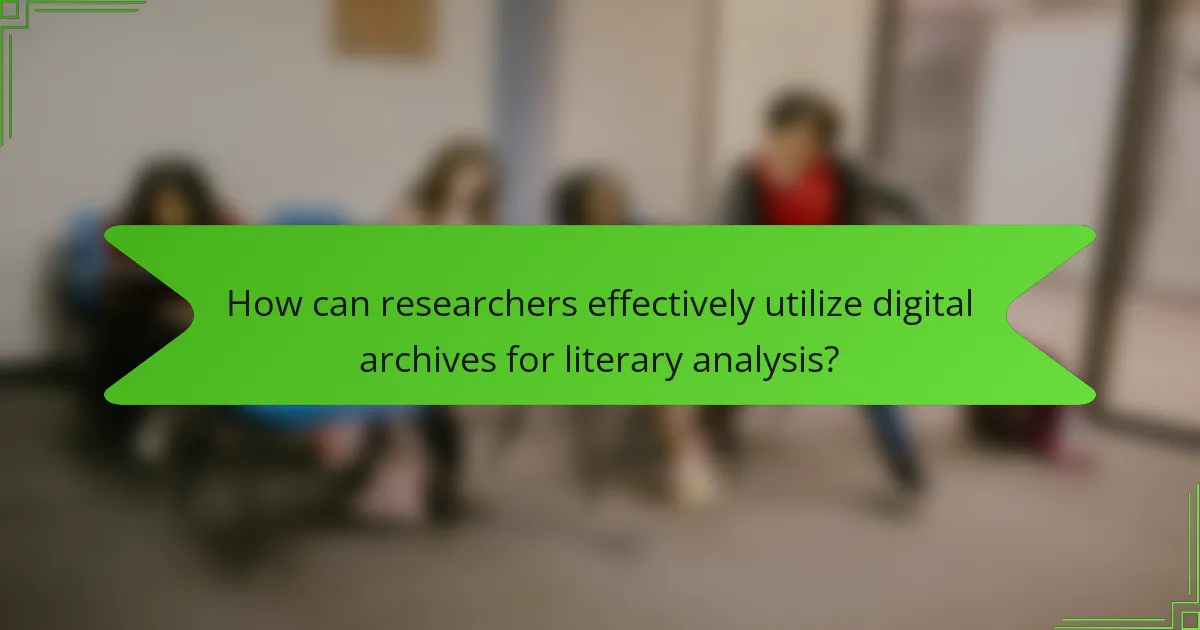
How can researchers effectively utilize digital archives for literary analysis?
Researchers can effectively utilize digital archives for literary analysis by leveraging advanced search tools, accessing a diverse range of texts, and employing data visualization techniques. Digital archives provide access to a wealth of Spanish literary works, enabling in-depth analysis of themes, styles, and historical contexts. They often include metadata that enhances research, such as publication dates and author backgrounds. Additionally, researchers can use text mining to uncover patterns and trends within large volumes of literature, making connections that traditional methods might overlook. Engaging with digital archives fosters collaboration among scholars, allowing for shared insights and interdisciplinary approaches to literary research.
What tools and methods enhance research outcomes using digital archives?
Digital archives enhance research outcomes for Spanish literary works through various tools and methods. Key tools include digital databases, text analysis software, and collaborative platforms that facilitate access to primary sources. Methods such as keyword searching, data mining, and digital mapping improve the discovery of literary trends and connections. Utilizing metadata standards ensures consistency in cataloging, while visualization tools help researchers interpret complex data. These approaches collectively enrich the understanding of Spanish literature and its historical context.
Which case studies highlight successful research projects using these archives?
Several case studies demonstrate successful research projects utilizing digital archives of Spanish literary works. One notable project is the “Digital Archive of Spanish Literature,” which facilitated access to rare texts and manuscripts, enhancing research capabilities. Another example is the “Cervantes Digital Archive,” which provides comprehensive resources for studying Miguel de Cervantes’ works, including annotations and historical context. The “Spanish Civil War Archive” showcases how digital tools can preserve and analyze literature from this pivotal period, offering insights into cultural narratives. These projects exemplify the transformative role of digital archives in enhancing literary research and scholarship.
What common pitfalls should researchers avoid when accessing digital archives?
Researchers should avoid common pitfalls like inadequate source evaluation, ignoring copyright restrictions, and neglecting metadata. These mistakes can lead to misinformation and hinder the quality of research.
Inadequate source evaluation may result in relying on unreliable or biased materials. Ignoring copyright restrictions can lead to legal issues and limit access to necessary resources. Neglecting metadata means missing critical information about the context, authorship, and authenticity of the works, which is essential for thorough analysis.
Additionally, failing to verify the credibility of digital archives can compromise the integrity of research findings. Researchers must prioritize source credibility, adhere to copyright laws, and utilize metadata effectively to enhance their exploration of Spanish literary works.
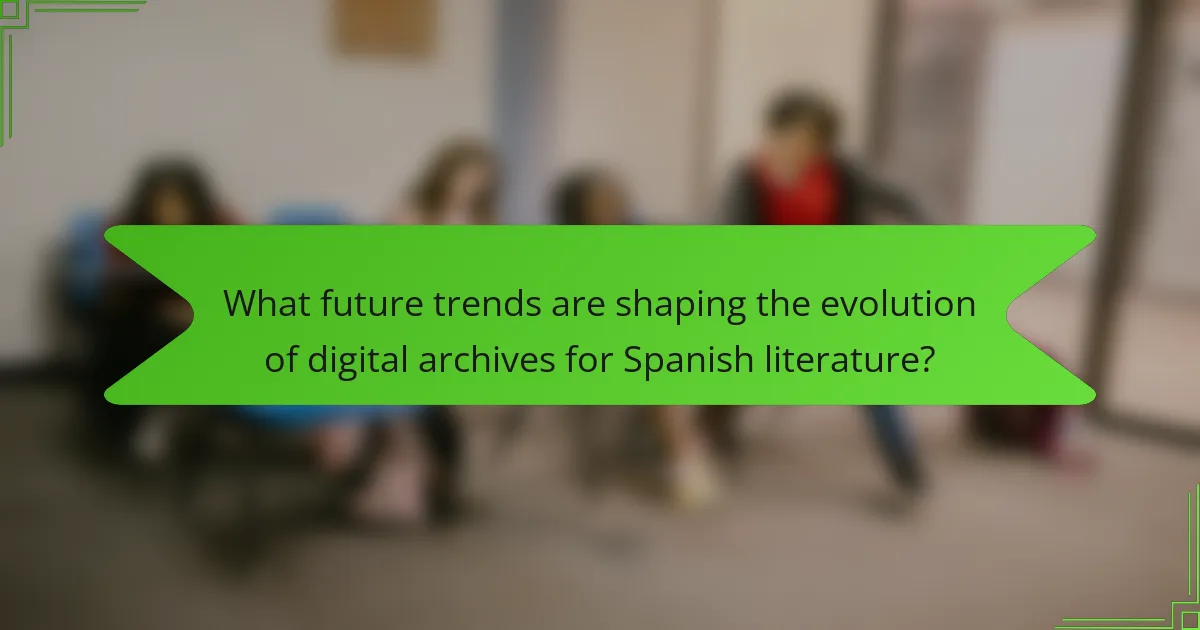
What future trends are shaping the evolution of digital archives for Spanish literature?
Emerging technologies and changing user preferences are shaping digital archives for Spanish literature. Key trends include increased use of artificial intelligence for text analysis, enhanced accessibility through mobile platforms, and the integration of multimedia elements to enrich the literary experience.
AI-driven tools are improving the categorization and searchability of texts, allowing researchers to uncover connections between works more efficiently. Mobile accessibility ensures that users can engage with archives anytime, broadening the audience for Spanish literature.
Additionally, the incorporation of multimedia—such as audio readings and video analyses—provides a richer context, making literary works more engaging. Collaborative platforms are also fostering community engagement, encouraging shared annotations and discussions among users.
These trends collectively enhance the preservation, accessibility, and enjoyment of Spanish literary works, ensuring their relevance in a digital age.
How is technology influencing the preservation of literary works?
Technology significantly enhances the preservation of Spanish literary works through digital archives. These archives facilitate access, improve conservation, and foster research collaboration.
Digital platforms enable the storage of texts in various formats, ensuring their longevity. For instance, digitization projects like the Biblioteca Digital Hispánica provide extensive collections of Spanish literature, allowing global access.
The integration of metadata enhances searchability and contextual understanding. This attribute aids researchers in discovering connections between works and authors, enriching the literary landscape.
Moreover, technology supports the preservation of rare texts that might otherwise deteriorate. Virtual exhibitions and online repositories offer unique insights into Spain’s literary heritage, making it accessible to future generations.
What innovations are emerging in the field of digital archiving?
Innovations in digital archiving for Spanish literary works include enhanced metadata standards, AI-driven text recognition, and immersive digital experiences. These advancements improve accessibility and preservation, allowing researchers to explore texts in new ways. AI tools can analyze large volumes of literature, revealing patterns and insights previously unnoticed. Additionally, collaborative platforms enable scholars to contribute to and curate digital collections, fostering a community around Spanish literary heritage.
What strategies can researchers adopt to stay updated on new developments?
Researchers can adopt several strategies to stay updated on developments in Spanish literary works and research. Engaging with digital archives is crucial as they provide access to a wealth of primary sources. Subscribing to academic journals and newsletters focused on Spanish literature ensures timely information on new studies and publications. Participating in online forums and social media groups dedicated to literary research fosters collaboration and knowledge sharing. Attending virtual conferences and webinars expands exposure to emerging trends and methodologies in the field. Lastly, leveraging research databases and digital libraries allows for continuous exploration of novel content and scholarly discussions.
What expert tips can optimize the research experience within digital archives?
To optimize the research experience within digital archives for Spanish literary works, utilize advanced search techniques and effective organization strategies. Focus on specific keywords and phrases relevant to your research topic.
Leverage metadata features, such as author names and publication dates, to narrow down results efficiently. Familiarize yourself with the archive’s structure to locate resources faster.
Consider utilizing citation management tools to organize findings and streamline your research process. Engage with community forums or user groups related to the archive for additional insights and tips.
Lastly, regularly check for new additions to the archive to stay updated on the latest resources available for Spanish literary studies.
